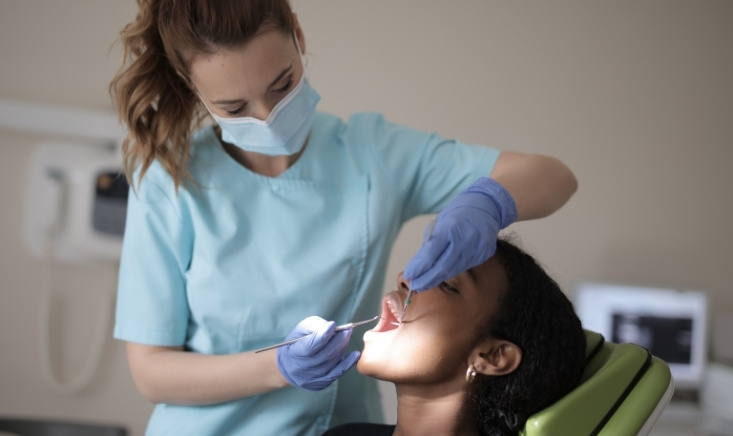How to Maintain Oral Hygiene Between Dental Visits?

Maintaining oral hygiene is crucial for overall health. Good oral care prevents serious issues like cavities and gum disease. Regular dental visits help monitor your oral health, but daily hygiene practices are equally important. The American Dental Association recommends visiting the dentist every six months.
However, what you do between visits significantly impacts your dental health. Proper oral care at home can reduce the risk of dental problems. This blog will guide you on maintaining oral hygiene between dental visits, ensuring your smile remains bright and healthy.
Understanding Oral Hygiene
Oral hygiene refers to practices that maintain the health of your mouth, teeth, and gums. Good oral hygiene prevents plaque buildup, bad breath, and serious conditions like gum disease. Neglecting oral care can lead to various dental issues.
For instance, plaque can harden into tartar, causing cavities. Cavities occur when bacteria in plaque produce acid that eats away at tooth enamel.
Additionally, gum disease can result from inflammation due to plaque buildup. Early signs of gum disease include red or swollen gums. If left untreated, gum disease can lead to tooth loss.
Studies also link poor oral hygiene to systemic conditions like heart disease and diabetes. Maintaining oral hygiene protects not only your smile but also your overall health. By prioritizing your oral care, you reduce the risk of dental problems and promote long-term well-being.
Daily Oral Hygiene Routine
Brushing
Brushing your teeth twice a day is essential. Choose a fluoride toothpaste to help prevent cavities. Use a soft-bristled toothbrush for gentle cleaning. Brush for at least two minutes each time. Focus on all surfaces: outer, inner, and chewing areas of each tooth. Replace your toothbrush every three to four months or sooner if the bristles fray.
Flossing
Daily flossing removes food particles and plaque between teeth, areas a toothbrush cannot reach. Use about 18 inches of floss, wrapping it around your middle fingers. Slide the floss gently between your teeth, curving it around each tooth. Avoid snapping the floss, as this can hurt your gums. Consider using floss picks or dental tape for easier handling.
Mouthwash
Using mouthwash can provide additional protection. Antiseptic mouthwash helps reduce bacteria, while fluoride mouthwash strengthens tooth enamel. Rinse with mouthwash for about 30 seconds after brushing and flossing. Look for mouthwash with the American Dental Association (ADA) seal for quality assurance. Use it once or twice daily for optimal results.
Diet and Its Impact on Oral Health
Your diet plays a significant role in oral hygiene. Certain foods can promote good oral health. Crunchy fruits and vegetables, like apples and carrots, help scrub teeth naturally. Dairy products, rich in calcium, strengthen tooth enamel. Drinking water also supports oral health by washing away food particles and bacteria.
However, some foods and drinks can harm your teeth. Sugary snacks and sodas can lead to cavities, as sugar feeds harmful bacteria in your mouth. Acidic beverages, like citrus juices and sports drinks, can erode tooth enamel.
Limiting these items can help maintain oral hygiene. Staying hydrated is crucial, too. Drinking water throughout the day supports saliva production, which helps neutralize acids in your mouth.
At-Home Tools and Products
Electric vs. Manual Toothbrushes
Both electric and manual toothbrushes can effectively clean your teeth. Electric toothbrushes may remove more plaque due to their speed and motion. They often include timers, ensuring you brush for the recommended two minutes. However, manual toothbrushes are more affordable and can be equally effective if used correctly.
Interdental Cleaners
Interdental cleaners, like floss picks and water flossers, help clean between teeth. Floss picks are convenient and easy to use, especially on the go. Water flossers use a stream of pulsating water to remove debris, making them suitable for those with braces or dental work. Choose the type that fits your comfort and needs.
Chewing Gum
Sugar-free gum can also support oral health. Chewing gum stimulates saliva production, which helps neutralize acids and wash away food particles. Look for gums with xylitol, a natural sweetener that reduces cavity-causing bacteria. Chewing gum can be a great option when you can’t brush your teeth after meals.
Managing Bad Breath
Bad breath, or halitosis, can result from poor oral hygiene, certain foods, or underlying health issues. Bacteria in the mouth produce sulfur compounds, leading to an unpleasant odor. Combat bad breath by practicing good oral hygiene and staying hydrated. Drinking water throughout the day can help wash away food particles and bacteria.
To freshen your breath, consider chewing sugar-free gum or using mouthwash. Additionally, eating crunchy fruits and vegetables can help clean your teeth and freshen your breath naturally. If bad breath persists despite good oral care, consult your dentist. They can help identify potential underlying causes and recommend appropriate treatments.
Recognizing Early Signs of Dental Issues
Recognizing early signs of dental issues is vital for maintaining oral health. Common symptoms include bleeding gums, persistent bad breath, and tooth sensitivity. If your gums bleed while brushing or flossing, it may indicate gum disease. Tooth sensitivity could signal underlying decay or enamel erosion.
If you notice any concerning symptoms, schedule an appointment with your dentist promptly. Regular check-ups allow your dentist to catch problems early and provide necessary treatments. Remember, your dental health significantly impacts your overall well-being, so do not delay seeking professional help.
Maintaining oral hygiene between dental visits is essential for a healthy smile. Proper brushing, flossing, and rinsing habits can reduce the risk of cavities and gum disease. A balanced diet, the right tools, and awareness of dental issues play crucial roles in oral health.
Remember, visiting the best dentist in Carrollton regularly will help you stay on track with your dental care. Start implementing these practices today for a healthier mouth and a brighter smile!




